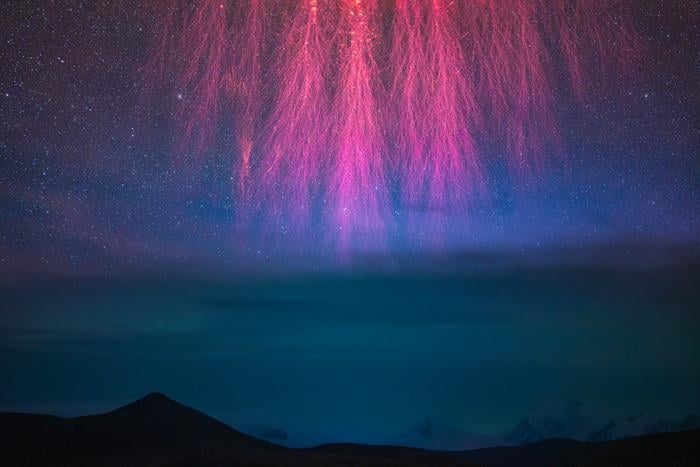Astrophotographers Help Scientists Solve Mystery of ‘Sprite Fireworks’

A pair of astrophotographers teamed up with scientists to help them solve the mystery of “sprite fireworks.”
On the night of May 19, 2022, two Chinese astrophotographers, Angel An and Shuchang Dong, captured a spectacular display of over one hundred red sprites over the Himalayas.
Red sprites are an elusive form of lightning that is discharged into the upper atmosphere, which scientists still don’t fully understand.
The pair of astrophotographers were shooting at an observation site, located on the southern Tibetan Plateau near Pumoyongcuo Lake, one of the region’s three sacred lakes.
Over a single night, An and Dong captured over 100 red sprites, vivid electrical bursts famed for their striking colors and delicate, otherworldly patterns.
The pair also recorded rarely seen secondary jets, and the first-ever recorded case in Asia of green airglow at the base of the nighttime ionosphere.
This extraordinary event attracted global attention and was widely covered by major media outlets. One of the photos, taken by An, even won the “Skyscapes” category of the Royal Observatory Greenwich’s 2023 Astronomy Photographer of the Year competition.
While these dramatic sprite fireworks are well-known, the details of how and why they form are still not fully understood.
In a recent study published in Advances in Atmospheric Sciences, a team of scientists led by Gaopeng Lu at the University of Science and Technology of China revealed how the astrophotographers’ images helped them begin to understand the complex interactions that result in these sprite fireworks.
Before studying the Himalayan red sprites, Lu and his team faced a challenge: the 2022 imagery by An and Dong didn’t have timestamps. Without knowing the exact time of the sprites, the scientists couldn’t connect them to the lightning strikes that caused them.
To solve this, the researchers took a creative approach. By identifying the sprites’ positions in the night sky and comparing them to satellite paths and star charts, they determined the timing of each sprite with a one-second margin of error. This allowed them to link about 70% of the sprites to their corresponding lightning events for further study.
“This event was truly remarkable,” study lead Professor Gaopeng Lu says in a statement. “By analyzing the parent lightning discharges, we discovered that the sprites were triggered by high-peak current positive cloud-to-ground lightning strikes within a massive mesoscale convective system. This suggests that thunderstorms in the Himalayan region have the potential to produce some of the most complex and intense upper-atmospheric electrical discharges on Earth.”
Image credits: Header photo by Angel An.